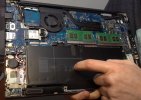I've recently started a new job and am in charge of my own system administration. This workplace requires Office 365 (Microsoft Teams, Outlook, etc.) and enterprise software. In addition, I'm going to be using Hyper-V, VSCode, WSL, and other development tools.
I bought a refurbished Dell Latitude 7490 and followed Hellbovine's Guide: Optimized Image to re-image my device. My main goal was to get rid of ads and software like Cortana to have a machine that's good enough to use for software development.
Right now, my machine seems to be stable, but not as usable as I'd like it to be. It overheats and makes a lot of noise from the fan, and doesn't sleep when the lid is closed, which I can't seem to change in the power and battery settings - all I can do is turn off the screen. I've resolved to shutting my computer down regularly, but this is inconvenient. Microsoft Teams / Office / Hyper-V might be the culprits here, but I can't get away from using them.
It's entirely possible that this is a hardware issue and I should return this laptop, but would a different setup be better for me? Not looking for high performance, just usability.
I bought a refurbished Dell Latitude 7490 and followed Hellbovine's Guide: Optimized Image to re-image my device. My main goal was to get rid of ads and software like Cortana to have a machine that's good enough to use for software development.
Right now, my machine seems to be stable, but not as usable as I'd like it to be. It overheats and makes a lot of noise from the fan, and doesn't sleep when the lid is closed, which I can't seem to change in the power and battery settings - all I can do is turn off the screen. I've resolved to shutting my computer down regularly, but this is inconvenient. Microsoft Teams / Office / Hyper-V might be the culprits here, but I can't get away from using them.
It's entirely possible that this is a hardware issue and I should return this laptop, but would a different setup be better for me? Not looking for high performance, just usability.

